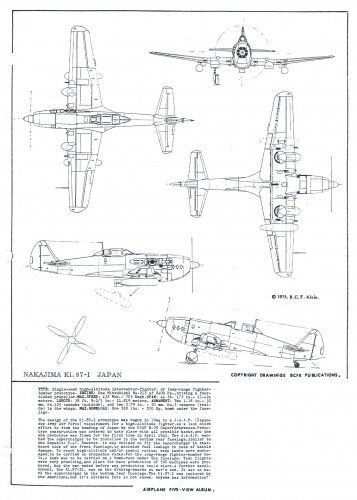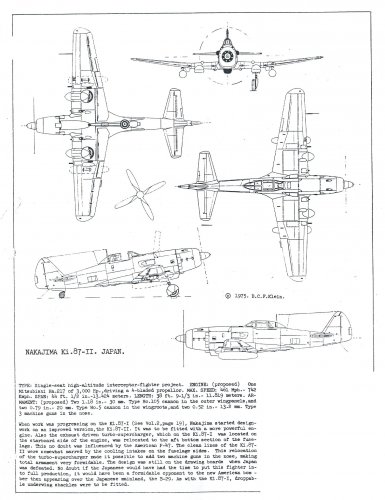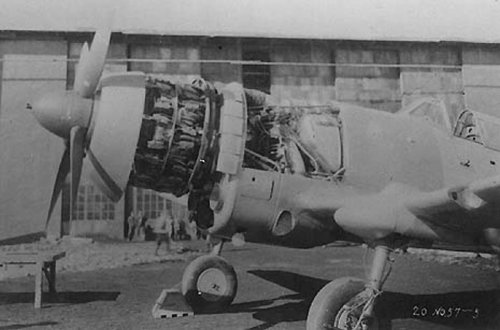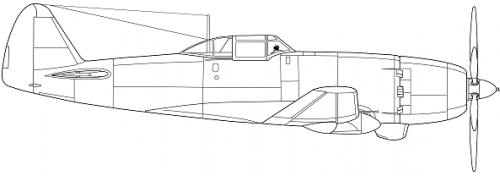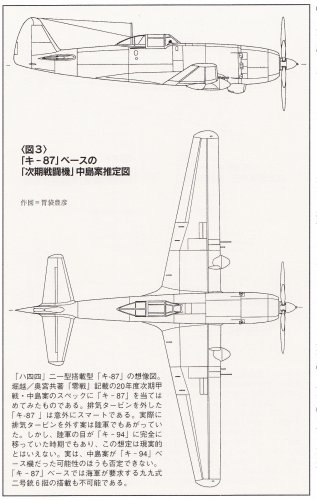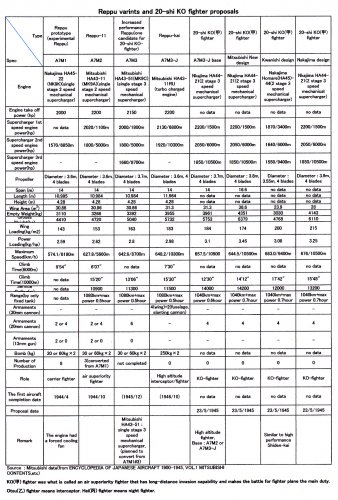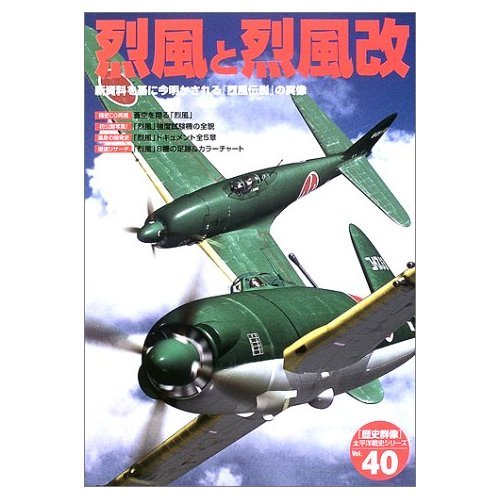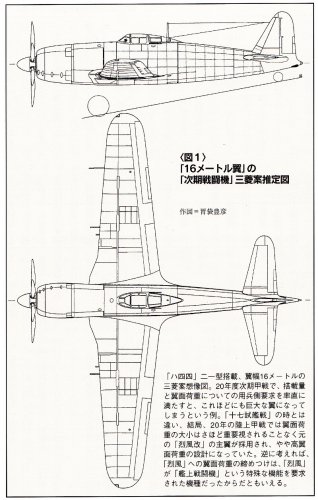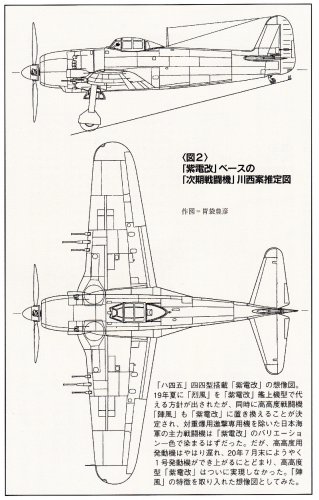You are using an out of date browser. It may not display this or other websites correctly.
You should upgrade or use an alternative browser.
You should upgrade or use an alternative browser.
Nakajima Ki.87-I & Ki.87-II
- Thread starter Justo Miranda
- Start date
Very interesting stuff Justo,I knew the Ki-87 model 1 but the Ki-87II is new to me,I must say the simplified engine nose looks better than the old nose! If this plane was put into service the Us B-29 were getting a very hard time above Japan!
Hoo-2b-2day
ACCESS: Confidential
- Joined
- 27 February 2008
- Messages
- 65
- Reaction score
- 11
The existence and superior planes such as the Ki-87-II and other such as the A7M Reppu would have made very little difference to the state of the airwar above Japan even if the war had continued into 1946/1947. This is due to Japans resources - it did not have anywhere near enough trained pilots to make use of these aircraft though a few individual pilots could make good use of better aircraft the fast majority of Japanese pilots in the latter stage if the Pacific war were barely able to fly let alone effectively fight airbattles.
The lack of good pilots came from 2 main reasons:
1. Due to extreme pilot losses in combat the Japanese were having to rush trainee's through the flight programs to get them to combat units as quickly as possible, and
2. The Japanese from late 1944 did not have the fuel to allow much flight training of pilots, and this included lack of air-time for even experienced pilots to master any new aircraft they were issued with.
To be an effective combat pilot takes heaps of training, including continued practice after qualifying as a pilot. Japan was not able to provide the time and fuel for this to take place therefor other than a few individual combats by very experienced pilots these improved faircraft would have made little if any impact on the airwar over Japan.
The lack of good pilots came from 2 main reasons:
1. Due to extreme pilot losses in combat the Japanese were having to rush trainee's through the flight programs to get them to combat units as quickly as possible, and
2. The Japanese from late 1944 did not have the fuel to allow much flight training of pilots, and this included lack of air-time for even experienced pilots to master any new aircraft they were issued with.
To be an effective combat pilot takes heaps of training, including continued practice after qualifying as a pilot. Japan was not able to provide the time and fuel for this to take place therefor other than a few individual combats by very experienced pilots these improved faircraft would have made little if any impact on the airwar over Japan.
blackkite
Don't laugh, don't cry, don't even curse, but.....
- Joined
- 31 May 2007
- Messages
- 8,821
- Reaction score
- 7,721
Many Japanese pilots suffered engine trouble, especially 3-shiki fighter Hien(飛燕) and Suisei(彗星)'s Atauta(熱田) engine(DB601) and Ki-84,Shiden-kai(紫電改)'s Homare(誉) engine. Japan could not develop high power liquid cooling engine and turbo supercharger until the end of the war. Also the fuel was very poor. But when Homare engine worked well with high octane fuel, Ki-84(Frank) marked 687km/h(6,096m) and shiden-kai marked 664km/h~680km/h(5,800-6,000m) in post war American test, faster than P-51D, P-47D and F-4U. Of course Ki-84 and Shiden-kai were strong in dog fight.
- Joined
- 22 April 2012
- Messages
- 2,258
- Reaction score
- 2,315
What is the story behind the Mitsubishi Ha.217 engine of the Ki-87 II? Did it have any relation to the Ha.50 of the Fugaku or was it just a development of the the Ha.215 (Ha.44)???
blackkite
Don't laugh, don't cry, don't even curse, but.....
- Joined
- 31 May 2007
- Messages
- 8,821
- Reaction score
- 7,721
HA217(HA47) was Nakajima designed 18 cylinder air cooling engine.(2,800hp in take off,150×180, 57.2L)
HA219(HA44) was Nakajima designed 18 cylinder air cooling engine.(2,450hp in take off,146×160, 48.2L) It was the first stage Fugaku's engine. (Mother engine of HA54 for Z-plane and alternative Fugaku second stage engine)
HA50 was Mitsubishi designed 22 cylinder air cooling engine.(3,500hp in take off,150×170, 66.1L)
It was the second stage Fugaku's engine.
http://www.ne.jp/asahi/airplane/museum/cl-pln10/2002cl/Ki87.html
http://www.ne.jp/asahi/airplane/museum/nakajima/Ki87Spec.html
http://www.hi-ho.ne.jp/a1takeda/ki-87.html
http://military.sakura.ne.jp/ac/ki87.htm
http://www.candymountain.jp/Home/planes/aviation.html
HA219(HA44) was Nakajima designed 18 cylinder air cooling engine.(2,450hp in take off,146×160, 48.2L) It was the first stage Fugaku's engine. (Mother engine of HA54 for Z-plane and alternative Fugaku second stage engine)
HA50 was Mitsubishi designed 22 cylinder air cooling engine.(3,500hp in take off,150×170, 66.1L)
It was the second stage Fugaku's engine.
http://www.ne.jp/asahi/airplane/museum/cl-pln10/2002cl/Ki87.html
http://www.ne.jp/asahi/airplane/museum/nakajima/Ki87Spec.html
http://www.hi-ho.ne.jp/a1takeda/ki-87.html
http://military.sakura.ne.jp/ac/ki87.htm
http://www.candymountain.jp/Home/planes/aviation.html
- Joined
- 22 April 2012
- Messages
- 2,258
- Reaction score
- 2,315
Apparently the production Ki-87-I would have had the turbo-supercharger in the rear fuselage so probably would have looked more like the Ki-87-II shown in this thread.
windswords
ACCESS: Secret
- Joined
- 19 May 2009
- Messages
- 389
- Reaction score
- 218
Yes please do post some scans. I hadn't known about this version of the Ki-87 until this thread. I would like to see more.
windswords
ACCESS: Secret
- Joined
- 19 May 2009
- Messages
- 389
- Reaction score
- 218
Taranov,
Thanks for the scans. they take a long time to load but they are worth it!
Thanks for the scans. they take a long time to load but they are worth it!
- Joined
- 22 April 2012
- Messages
- 2,258
- Reaction score
- 2,315
Can anyone clarify what engine the Ki-87 was actually using? Some sources say it was a Mitsubishi engine called the Ha-215 whilst others say it was the same Ha-219RU that was used in the Tachikawa Ki-94-II..?
blackkite
Don't laugh, don't cry, don't even curse, but.....
- Joined
- 31 May 2007
- Messages
- 8,821
- Reaction score
- 7,721
Nakajima Ki-87-Ⅰ's engine was a Nakajima HA219RU(HA44-12 RU) 18 cylinder air cooling turbo charged engine.(2,450hp in take off/2800rpm, 2040hp/11000m/2700rpm, bore146mm×stroke160mm, displacement 48.2L, length 2110mm, diameter 1280mm, dry weight 1150kg, compression ratio 7.5) same as Tachikawa Ki-94-Ⅱ's engine.JFC Fuller said:Can anyone clarify what engine the Ki-87 was actually using? Some sources say it was a Mitsubishi engine called the Ha-215 whilst others say it was the same Ha-219RU that was used in the Tachikawa Ki-94-II..?
In addition, Nakajima Ki-87-Ⅱ's engine was a Nakajima HA217(HA46) turbo charged engine, take off power 3000hp.
In March 1944, the IJA ordered Tachikawa to develop Nakajima Ki-87's design with pressurized cabin. BTW Tachikawa judged that Ki-87's high altitude performance was not enough, and Nakajima had their own Ki-87 develop plan which had pressurized cabin.There were possibility of Ki-94 cancellation, Tachikawa offered to terminate Ki-94 project to the IJA. The IJA angried with this offer very much and forced Tachikawa to develop Nakajima Ki-87's design with pressurized cabin. At the time, Nakajima asked Tachikawa to offer pressurized cabin technology. Then Tachikawa decided to develop normal shape Ki-94-Ⅱ and the IJA agreed with this.Then Ki-87 with pressurized cabin plan was terminated. The IJA picked Ki-94-Ⅱ as the high altitude fighter and had mass production plan.(Also the original Ki-87 had 300 aircrafts mass production plan. BWT it's test result is bad(turbo charger), the IJA almost gave up to develop original Ki-87)
Attachments
- Joined
- 22 April 2012
- Messages
- 2,258
- Reaction score
- 2,315
Thanks blackkite, thats what I thought; the HA-215 reference appears in a number of places but does not make any sense.
So I guess that the HA-44-14 proposed for the Ki-117 did not have a turbocharger, what about a supercharger?
So I guess that the HA-44-14 proposed for the Ki-117 did not have a turbocharger, what about a supercharger?
blackkite
Don't laugh, don't cry, don't even curse, but.....
- Joined
- 31 May 2007
- Messages
- 8,821
- Reaction score
- 7,721
Ki-117's engine was a Nakajima HA-44-13 engine. It had a single stage 2 speed or 3 speed mechanical supercharger. I'm not sure 2 speed or 3 speed. I guess 2 speed because Ki-117 was a medium altitude fighter.
blackkite
Don't laugh, don't cry, don't even curse, but.....
- Joined
- 31 May 2007
- Messages
- 8,821
- Reaction score
- 7,721
Oh it's the artistic impression for Nakajima 20-shi KO fighter proposal.
The engine was a Nakajima HA44-21 non turocharged engine. This engine had 2stage 3 speed mechanical supercharger.
There is a opinion that Nakajima 20-shi KO fighter was a Tachikawa Ki-94-Ⅱ base design.
Source : Reppu and Reppu-kai(烈風と烈風改), Gakken ISBN4-05-602990-3,1/2/2003(excellent book)
The IJN gave up to use turbo charged engine or vulkan coupling applied engine for 20-shi KO fighter.
It's hard to use these technologies for Japan at the day. (Lack of heat resistant materials, not educated and not experienced workers such as ladies and girls)
The engine was a Nakajima HA44-21 non turocharged engine. This engine had 2stage 3 speed mechanical supercharger.
There is a opinion that Nakajima 20-shi KO fighter was a Tachikawa Ki-94-Ⅱ base design.
Source : Reppu and Reppu-kai(烈風と烈風改), Gakken ISBN4-05-602990-3,1/2/2003(excellent book)
The IJN gave up to use turbo charged engine or vulkan coupling applied engine for 20-shi KO fighter.
It's hard to use these technologies for Japan at the day. (Lack of heat resistant materials, not educated and not experienced workers such as ladies and girls)
Attachments
- Joined
- 22 April 2012
- Messages
- 2,258
- Reaction score
- 2,315
Blakkite, thank you again!!!
Did the 20-Shi fighter keep the pressurised cockpit of the Ki-87 and Ki-94 or did it have a standard non-pressurised cockpit? If it did not have a pressurised cockpit it seems to be very similar to the Ki-117.
Was a final design ever chosen by the IJN for the 20-Shi specification?
Did the 20-Shi fighter keep the pressurised cockpit of the Ki-87 and Ki-94 or did it have a standard non-pressurised cockpit? If it did not have a pressurised cockpit it seems to be very similar to the Ki-117.
Was a final design ever chosen by the IJN for the 20-Shi specification?
blackkite
Don't laugh, don't cry, don't even curse, but.....
- Joined
- 31 May 2007
- Messages
- 8,821
- Reaction score
- 7,721
In September 1945, Kugisho(of the IJN) reported to the U.S. that KO fighter which under development were Shiden-kai with Nakajima Homare HA45-44 engine, Reppu with Mitsubishi HA43-51 engine and Reppu with Nakajima HA44-21 engine.JFC Fuller said:Blakkite, thank you again!!!
Did the 20-Shi fighter keep the pressurised cockpit of the Ki-87 and Ki-94 or did it have a standard non-pressurised cockpit? If it did not have a pressurised cockpit it seems to be very similar to the Ki-117.
Was a final design ever chosen by the IJN for the 20-Shi specification?
These fighters had air combat flap, but did not have pressurized cabin. You can find these fighters easily in my table.
In addition, the IJN ternimated to use Shi naming system for experimantal aircraft in 1943, so 20-shi KO fighter was not a official name.
Source : Reppu and Reppu-kai, Gakken
While the IJA's high altitude interceptor Tachikawa Ki-94-2 which under development had Turbo charged HA-44 engine, ressurized cabin and laminar flow wing.
blackkite
Don't laugh, don't cry, don't even curse, but.....
- Joined
- 31 May 2007
- Messages
- 8,821
- Reaction score
- 7,721
- Joined
- 25 June 2009
- Messages
- 14,758
- Reaction score
- 6,165
blackkite said:In addition, the IJN ternimated to use Shi naming system for experimantal aircraft in 1943, so 20-shi KO fighter was not a official name.
Exactly. No 20-Shi for 1945 and no 19-Shi either for 1944...
blackkite
Don't laugh, don't cry, don't even curse, but.....
- Joined
- 31 May 2007
- Messages
- 8,821
- Reaction score
- 7,721
Hmmmm......I can't find the name N1K6-J in Japanese sources.gerhard said:Hi Guys.
[font=]Would the Kawanishi 20-shi Ko fighter be called: Kawanishi N1K6-J Shiden-Kai?[/font]
windswords
ACCESS: Secret
- Joined
- 19 May 2009
- Messages
- 389
- Reaction score
- 218
gerhard said:Hi Guys.
[font=]Would the Kawanishi 20-shi Ko fighter be called: Kawanishi N1K6-J Shiden-Kai?[/font]
My guess is that the design proposal never went forward enough to be given an official designation - But I think that N1K6-J would have been logical.
blackkite
Don't laugh, don't cry, don't even curse, but.....
- Joined
- 31 May 2007
- Messages
- 8,821
- Reaction score
- 7,721
Yes I think so,too. Good guess.windswords said:gerhard said:Hi Guys.
[font=]Would the Kawanishi 20-shi Ko fighter be called: Kawanishi N1K6-J Shiden-Kai?[/font]
My guess is that the design proposal never went forward enough to be given an official designation - But I think that N1K6-J would have been logical.
Similar threads
-
Nakajima Ki-87 and it's development plan
- Started by blackkite
- Replies: 49
-
-
-
Nakajima Ki-84 advanced versions and derivatives
- Started by airman
- Replies: 135
-

